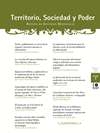Resumen
Resumen: El presente trabajo supone un balance sobre los modelos teóricos y los métodos utilizados en el estudio de la organización social del espacio en época medieval, abordado desde las diferentes perspectivas que aportan las nuevas tendencias historiográficas francesas. No se puede obviar en este tema la omnipresente influencia de autores clásicos como Marc Bloch y su longue durée, o Charles Higounet y su concepto de la geografía histórica. Sin embargo, la evolución de los estudios en esta materia en las últimas dos décadas viene marcada por el desarrollo del concepto del village entre los historiadores, siguiendo los estudios de Pierre Toubert y Robert Fossier, y por la influencia de la arqueología espacial entre los arqueólogos, que tienden cada vez más a centrarse en el estudio del paisaje. Se produce así una bifurcación de la investigación en el campo del análisis territorial y una cierta ruptura entre arqueólogos e historiadores, en cuanto que adoptan diferentes perspectivas y modelos teóricos a la hora de abordar el estudio de la organización social del espacio en la Edad Media.
Palabras clave: territorio, formas de hábitat, village, historiografía francesa.
Abstract: The current piece of work represents an evaluation of the theoretical models and methods used when studying the social organization of space during Medieval times, approaching from the different points of view provided by the new French historical tendencies. Regarding this topic, it can’t be overlooked the omnipotent influence of the classic authors as Marc Bloch and his longue durée, or Charles Higounet and his concept of Historical Geography. Nevertheless, the evolution of the studies on this subject in the past two decades, has split up into two main branches of research. On the one hand, there are the Medieval French historians, who follow Pierre Toubert’s theoretical models (Théorie de l’incastellamento) and Robert Fossier. They are in constant revision of these concepts, focussing on the study of habitat regrouping and the birth of the medieval village around a polarization centre, being it a secular o religious one. On the other hand, the archaeologists, influenced by Space Archaeology or Landscape Archaeology, whose search for an interdisciplinary methodology, has produced a progressive approach towards geography and the different disciplines within natural science. It is in this second big research branch where in recent years new tendencies have emerged, such as the Landscape Ecology and the Géoarqueologie; From different perspectives, they deal with the study of the historical space based in aspects such as the man-natural environment interaction in the different historical eras. Another one is Archéomorphologie, which focuses in the study of the lot system in the longue durée, that means, from the point of view of a diachronic perspective. This will allow us to see the permanence of some lots and the disappearance of others along time. All in all, the archaeologists, in the field of the analysis of historical space, are more and more orientated towards focusing in the study of landscape and the dynamic evolution of the forms conforming it, in a diachronic sense, leaving in a second term the socio-economic aspects. Regarding the usage of the methodology, without any doubt, interdisciplinarity is looked for and also cooperation between the different disciplines (geography, natural sciences, cultural anthropology, etc.), using resources such as prospecting and archaeological excavation, the written sources, the toponimy, the cartography or aerial photography. Nevertheless, while within historians there continues to be a certain tendency to be based on written texts and toponymy as historical sources, with a progressive incorporation of the data provided by archaeology, the archaeologists are more and more reluctant to use toponymy as a reliable source to establish chronologies, (although they value the importance of the data provided by microtoponymy) and they prefer to compare the data obtained from other kind of sources. This outlook involves, in a way, an epistemological and methodological breach between archaeologists and historians who adopt different theoretical models and different time-space scales, when approaching the study of the social organization of the space during the Medieval Age.
Keywords: territory, habitat, village, french historiography.

